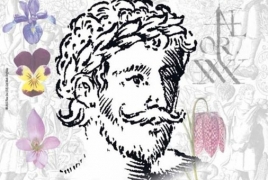Shakespeare's "real face" appears in botany book May 19, 2015 - 15:50 AMT PanARMENIAN.Net - A 400-year-old botany book contains what could be the only known portrait of Shakespeare made in his lifetime, according to an academic expert, BBC News reports. Botanist and historian Mark Griffiths cracked an "ingenious cipher" to identify the playwright in an engraving in the 16th-Century work. "This is what Shakespeare looked like, drawn from life and in the prime of life," he said. Details of his discovery are revealed in this week's issue of Country Life. Mark Hedges, the magazine's editor, hailed it as "the literary discovery of the century". Speaking at London's Rose Playhouse on Tuesday, May 19, he said: "We have a new portrait of Shakespeare, the first ever that is identified as him by the artist and made in his lifetime." He said Griffiths' "unrivalled specialist knowledge" as an expert in the role of flora in the literature of the English Renaissance made him "uniquely qualified to discover the greatest Elizabethan of all." It is not the first time such claims have been made about a Shakespeare portrait. In 2009, a painting known as the Cobbe portrait was put on show by the Shakespeare Birthplace Trust in Stratford-upon-Avon. The trust said it was convinced the artwork - thought to date back to 1610 - was an authentic portrait, but some critics said the picture was not of Shakespeare. Griffiths made his discovery when he was researching the biography of pioneering botanist John Gerard (1545-1612), author of The Herball or Generall Historie of Plantes. The 1,484 page book, published in 1598, is described as the largest single-volume work on plants that has been published in English. The title page is illustrated with an engraving by William Rogers depicting four figures, which were thought to have been imaginary. However, as Country Life reports, Griffiths decoded decorative devices around the figures - such as heraldic motifs and emblematic flowers - to reveal their "true identities". They are, he says, the author Gerard, Rembert Dodoens, a renowned Flemish botanist, and Queen Elizabeth's Lord Treasurer, Lord Burghley. The fourth man holds a fritillary and an ear of sweetcorn - plants which Griffiths says point to Shakespeare's poem Venus and Adonis and his play Titus Andronicus. Beneath the bearded fourth man was "an ingenious cipher of the kind loved by the Elizabethan aristocracy" which, decoded, confirmed his identity as "William Shakespeare". Griffiths writes in Country Life: "The Fourth Man is not cartoonish or stylised. It may be monochrome, in fancy dress, and just 3.5 inches tall, but this is something that has been sought for centuries." He goes on: "By the time that portraits of Shakespeare were at a premium, the significance of the Rogers engraving had faded from memory. Its camouflaged figures, coded plants and ciphers proved too clever for its own good. "The title page, one of the richest and most important artworks of the English Renaissance, came to be seen merely as a bibliophile's rarity and a fine, if stereotypical specimen of Elizabethan decoration. Nobody dreamed of finding Shakespeare in it." Photo: Rex-Features Related links: The creative crew of the Public TV had chosen 13-year-old Malena as a participant of this year's contest. She called on others to also suspend their accounts over the companies’ failure to tackle hate speech. Penderecki was known for his film scores, including for William Friedkin’s “The Exorcist”, Stanley Kubrick’s “The Shining”. The festival made the news public on March 19, saying that “several options are considered in order to preserve its running” Partner news |